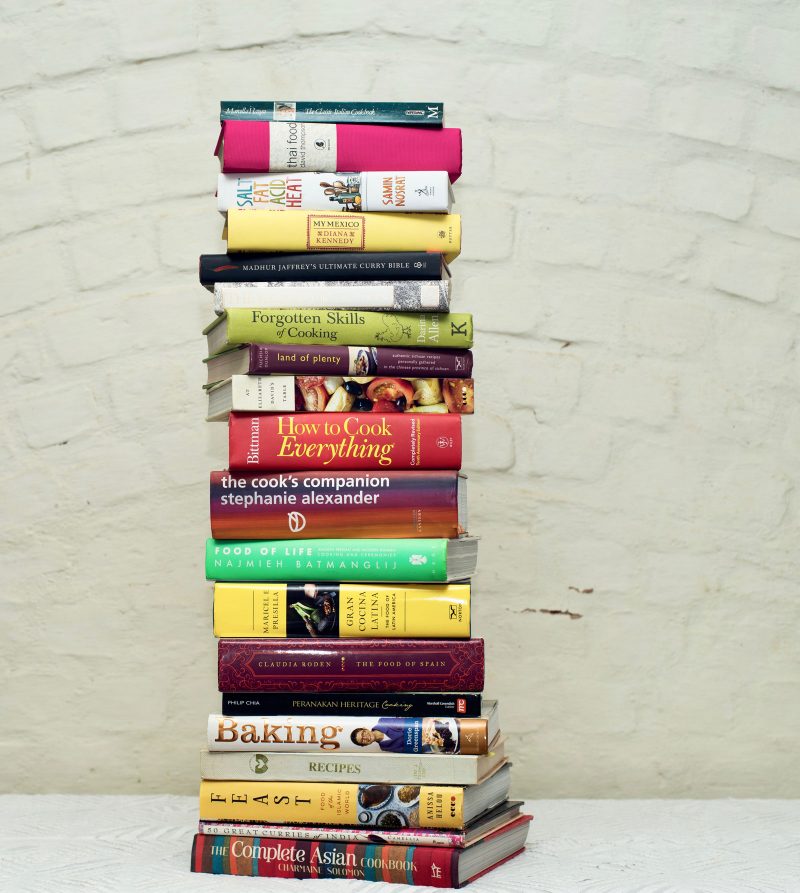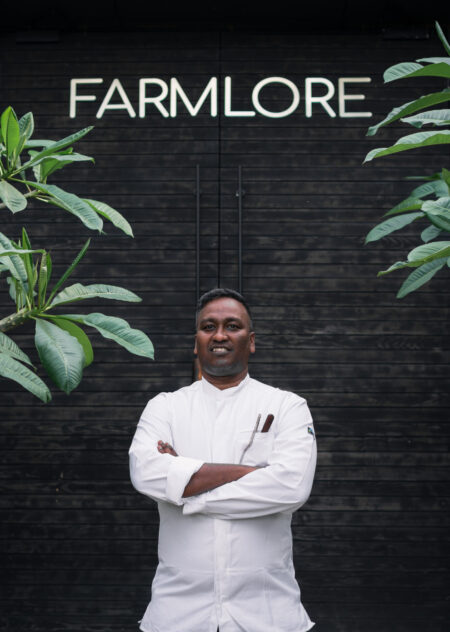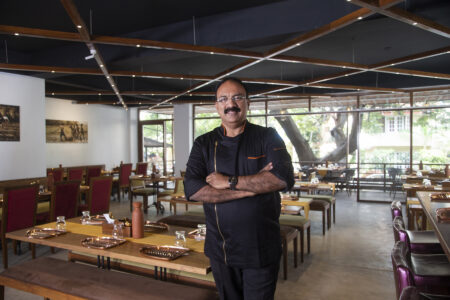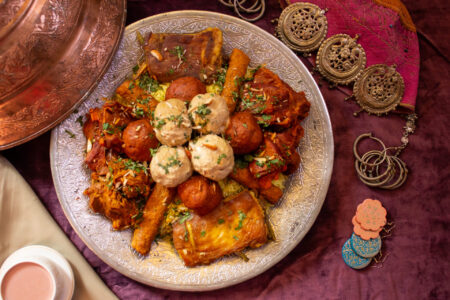Several decades of collecting cookbooks have taught me one thing: they are not going out of fashion quickly, or at all. Despite the internet, with its millions of recipes, probably as many blogs, and the ease of googling what to cook for lunch or dinner, cookbooks are still being published and consumed in staggering quantities that should make them the envy of the rest of publishing world. Between the pages of the teetering, towering piles of cookbooks that now occupy the house, are fine pieces of literature; outstanding travel journals; cultural histories of conquest, trade and migration; instructions on how to improve your cooking and, of course, recipes for excellent food. The 20 titles here have been selected for one or all of these reasons.
- Perhaps the most idiosyncratic one of all, overflowing with superb recipes, the kind which are being irrevocably lost every day, is the Time and Talents Club Cookbook. Founded in Mumbai by Gool Shavaksha, in 1935, the Time and Talents Club was made up of a group of wealthy, privileged women, mostly Parsi, given to philanthropic works. The cookbook, which was a community effort, has been reprinted six times since publication. The instructions are brief to the point of being abrupt, and there isn’t so much as a line drawing in sight —but that’s where the real food of home cooks come in. The selection process to have a recipe included involved presenting cooked dishes to a committee, followed by a tasting and discussions, before the final choices were made —something I’ve been witness to in a far-flung tea plantation community in Tamil Nadu. Where else will you learn how Dolly P. Pavri made the most divine prawn cutlets and Jerbai D.F. Mulla, Quail Pickle? Organ meats and offal, now making a comeback, feature in uncommon dishes. There are dozens of family recipes from home cooks across the world, from an era that devoted time to great home food.
- If you own three different editions of the same book —it this case, Charmaine Solomon’s The Complete Asian Cookbook, it must be with good reason. A journalist by training, Solomon was typing a manuscript for cookery legend Margaret Fulton, when the publisher suggested she write one herself. What followed was years of extensive travel and learning, and over a million copies of her book, in five languages, sold since 1976. With deep family ties in Myanmar, the section on Burmese food is one of the best, with a stellar recipe for Panthe Kaukswe which I have cooked more often than I can recall. Charmaine was married to the renowned jazz musician Ruben Solomon and she recounts how, when he returned home in the early hours of the morning from concerts, the two would cook and sing together. This passion for, and enjoyment of food comes through on every page of the book.
- Regional Indian food is so trendy today that it’s easy to forget Camellia Panjabi’s pioneering efforts to introduce the home cooking —particularly of the southern states —to the restaurants of the Taj Hotels, and a wider audience, a couple of decades ago. 50 Great Curries of India documents the recipes gathered from home cooks across the country in a single, thoroughly researched volume, and includes dishes such as Sindhi Elaichi Gosht; Bori Curry, and Kori Gashi —now a household name.
- The map on the endpapers shows a broken red line crisscrossing continents and oceans, often tangled and doubling back on itself. Madhur Jaffrey’s The Ultimate Curry Bible traces the journey of curry through ancient trade; cultural and political ties; colonialism; immigration and the often, heart-breaking stories of indentured Indian labour transported across the globe, which gave us stunning dishes like Curried Whole Chicken, Durban Style. Guyanese Goat Curry mingles old and new ingredients and cooking techniques, while racial segregation was the unlikely inspiration for the Durban creation, Bunny Chow: a small, hollowed out loaf of bread with a filling of curry, overflowing with flavours. Japan’s curry obsession, possibly dating as far back as the 19th century, is made with a readymade roux, and there’s a recipe for Japanese-Style Beef Curry in the book if you wish to try it.
- One of the most flavourful hybrid cuisines that emerged from the historical events described in Madhur Jaffrey’s book is Peranakan: the food of early Chinese immigrants to the Straits Settlements of Singapore, Malacca and Penang. The heady mix of aromatics, layers of spice, and distinctive regional variations go into making some of the most exciting dishes. Philip Chia’s Peranakan Heritage Cooking has several family recipes —Ikan Gerang Asam (fish with tamarind); Otak-Otak Panggang (aromatic fish in banana leaves) and Sugee Almond Butter Cake that traces its roots to Goa through the Portuguese, via Malacca; amongst the recipes for Kueh — bite sized snacks or desserts —is Kueh Lapis Rempah, near identical to the Goan Bebinca. Each dish speaks about a unique heritage.
- History, society, culture and tradition frame food in David Thompson’s Thai Food, a tome that will not sit comfortably on your kitchen countertop. But it will give you context for the brilliant balance and profusion of flavours and textures that manage to harmonize in Thai dishes, and a clear idea how to cook Hot, Salty, Aromatic Jungle Fish Curry. The delicate Cucumber and Prawn Salad from Ayuthyia and a rich, Mussaman Beef Curry are some of my many favourites.
- Siri Owen was awarded the Guild of Foodwriters’ Lifetime Achievement Award in 2017. The Indonesian author writes in The Rice Book: “It shapes our landscapes and the way we live”. Much of Asia’s cuisine is defined by rice, and Owen paints a breath-taking picture of agriculture, myths and the vital irrigation systems needed for growing rice. Recipes for risottos; sushi; Crawfish Etouffée from New Orleans; Paella Valenciana from short-grain rice that has been cultivated since the Moorish invasion of Spain; Fish Plov, a Russian dish borrowed from Central Asia and Sumatran Goat Curry are placed against this backdrop.
- The Food of Sichuan, an updated edition of Fuchsia Dunlop’s Land of Plenty is just published. A fluent Mandarin speaker and authority on Chinese food, she gives us a fantastic overview of the 23 flavours and 56 cooking methods in Sichuan, along with Five-Spiced ‘Smoked Fish’; Spicy Cold Noodles with Chicken Slivers, interspersed with history and stories: like Mr. Lai’s dumplings that survived the craze for fast food, located right below a branch of KFC.
- Books that provide the essential foundations of cooking tend to be very large, almost without exception. Mark Bittman’s How to Cook Everything lives up to its title, even offering a recipe for Manchurian Style Cauliflower —Gobi Manchurian —from Kolkota’s Chinatown. With 2000 excellent recipes, possibilities and information all along the way, it’s perfect for easy reference.
- Stephanie Alexander, Australian chef and food educator writes considering ‘what the reader will have on hand’. This happens to include kangaroo and wallaby. The Cook’s Companion is a hefty tome, somewhat prosaic in tone, but replete with information and a deep understanding of raw materials. Pineapple and Rum Pickle to be eaten with Smoked Ham and Twice-Cooked Zucchini Soufflés are just the tip of the iceberg of recipes contained within its pages.
- Salt Fat Acid Heat distils the principles of balance in cooking to just four elements: the title of the book. Samin Nosrat’s first sentence, “Anyone can cook anything and make it delicious” sums up the liberating voice that runs through the pages, encouraging improvisation based on an understanding of these central elements. The quirky illustrations, the clear, conversational tone take all the weight off the enormous experience packed between the pages. The engaging Netflix Series should bring you straight to this indispensable book and Nosrat’s infectious love of life.
- Forgotten Skills is the title of a course taught at the Ballymaloe School of Cookery. Darina Allen’s The Forgotten Skills of Cooking is a glowing gem of a book that re-establishes our relationship with the food we eat: how it is grown and procured, and how it should be consumed —with deep respect and minimum waste, reminding us of the intricate web of relationships that link us to the landscape we inhabit. Decades of cooking experience and inherited wisdom are condensed into a few lines sketching out uncomplicated flavours — pan-grilled fish with flavoured butter; mackerel with almond migas (to use up stale breadcrumbs). Disappearing skills are revived and made relevant.
- “I think of this as a kitchen journal I meant to keep, but never did”. Dorrie Greenspan offers solutions, options and a notes-in-the-margin commentary right through Baking: From My Home to Yours. Whether you are making Perfection Pound Cake, Cocoa Almond Meringues, or any of this collection of her favourite recipes, Greenspan’s clear and present voice is with you. Of the dozens of books on baking I have used, this is the one I will keep.
- The direct tone, the clear instructions and recipes that work come from a woman who is credited to have changed the way America cooked Italian food. Critics who find her voice instructive must remember she was an academic, who went on to run cooking schools. Marcella Hazan’s The Classic Italian Cookbook is exactly what it the title says —a classic. The now famous three-ingredient tomato sauce, Red Snapper simmered in wine and broth and Pot-Roasted Chicken with Garlic and Rosemary all highlight simple techniques that emphasise flavour, and her short passages on food are memorable.
- Literature and anthropology dictate my choice of the next few books. Elizabeth David, referred to as “The most important cookery writer of the 20th century” is credited to have changed the way people ate in Britain. At Elizabeth David’s Table, published on the 60th Anniversary of her first book, has recipes interspersed with essays in her elegant, direct style shot through with sometimes acerbic wit. The recipes —like Chicken Pot-Roasted with Fennel and Ham —are simple, but draw on serious knowledge, and you keep re-reading the accompanying words.
- My Mexico is an acutely observed gastronomic travelogue written in spare, evocative prose, as Diana Kennedy documents native edible plants, driving to remote parts of Mexico —home since 1976 — in search of ingredients, recipes and cooking techniques. She visits homes, local markets and traditional restaurants, recording stories. Unmatched descriptions and deep insights come of these journeys. You are inspired to cook dishes you have never heard of —like Minilla Veracruzana — to eat with toast or rice.
- The great arc described by Islam from its birthplace in Mecca, across the Arab world, Africa, the Mediterranean and Asia absorbed local cultures, cuisine and ingredients. Feast traces culinary traditions and specific dishes of the Abbasids, Ottomans and Mughals as they are transformed by other cultures and landscapes. Anissa Helou’s scholarship and first-hand knowledge sweep us across continents, into homes and marketplaces. The section on spices and spice mixtures alone is remarkable. Qatari Festive Rice and Chicken has a very long list of ingredients which, once assembled, produces a dish of stunning flavours.
- Najmieh Batamanglij’s gorgeous Food of Life plunges into the long history and sophisticated culture of Persian cooking traditions. The title is drawn from nush-e-jan, ‘food of life’; Jewelled Rice with Barberries and Pistachios, Fresh Herb Khoresh with Leg of Lamb, and many other delicate and refined dishes are recorded. The book itself is a reflection on the poignant, quite state of exile in which many Iranians live today.
- A magnificent confluence of Spain, Africa and pre-Colombian America held within its covers, Gran Cocina Latina places the rich and diverse food traditions of Latin America in their cultural context. Maricel Presilla, academic, chef and co-owner of two restaurants, traces diverse cultures and their complex intersections through recipes. Puerto Rican Salt Cod Fritters and other delectable ‘Little Latin Dishes’; Big bellied Argentinian Beef Empanadas; Mackerel Tiradito in Bitter Orange Juice —one of the most appealing and intense cuisines in the world, it blends elements from Asia, Africa and elsewhere.
- The Food of Spain recreates a world of conquest and the struggle to reclaim a land: a world that Claudia Roden recreates though food, tracing the stories behind individual dishes. The variety and complexity of Spanish cooking is a result of multiple cultures clashing, retreating and finally coming together. Roden writes elegantly of Fish in Onion and Saffron Sauce and Tarta de Santiago, while observing that brilliant young Basque chefs, wishing to provoke memories and emotions, are looking to their roots for inspiration —bringing us full circle to the best home cooking.
This article was published in the 20th Anniversary Issue, Volume 20, Fourth Quarter, UpperCrust Magazine





Hi I am looking for The Vanishing kodavas book is not available in Bangalore.
Thanks for your query, The Vanishing Kodavas is sold out.
Hello. Are any of these books available now ???
Hi Nitin, many of these books are available on Amazon. Do check them out. Kaveri